If you want to add a jazzy edge to your guitar playing, using 9th chords is a powerful tool that adds a smooth and sophisticated sound to your music. Before learning 9th chords, I recommend first checking out the guide on 7th chords if you don’t know them already.
In this lesson, we’ll cover 8 ways to play the C minor 9 aka C minor 7 (9) chord and show you how it works. Grab your guitar and let’s get started!
C minor 9 chord theory
Whenever you see a minor 9, this implies a minor 7 chord with an added 9th interval. This means the chord has the following chord tones: 1, b3, 5, b7, and 9.
For example, the C minor 9 chord has the notes C, Eb, G, Bb, and D.
The extension of the 9th note adds a nice tension to your chord as you’ll hear in the examples ahead.
Here is the formula for minor 7 (9) chords below.

Note that chord names are interchangeable such as C minor 9, C min 9, C m 9, or C minor 7 (9).
Now that you know what notes belong to the chord structure, let’s look at how to read the chord charts.
How to read the chord charts
For the charts below:
- The top horizontal line of the chord chart represents the high E string and the bottom horizontal line represents the low E string.
- The vertical lines separate each fret.
- The numbers in the blue dots tell you which fingers to use on the fretting hand.
- The letters on the right of the charts tell you what notes you are playing on each string.
- Circles on the left represent open strings.
- Red X means to avoid that string.
You can check this link for more about reading guitar notation symbols.
1. C minor 9 on the 5th string
First up, here is a typical way to play this chord.
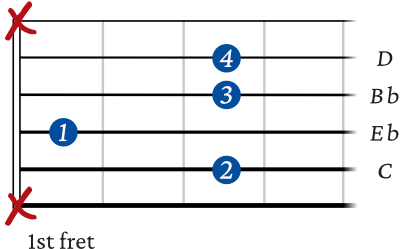
2. C minor 9 barre on the 6th string
This barre chord can be challenging if you’ve never played this before. If needed, the next shape shows you a simpler version based on this chord.
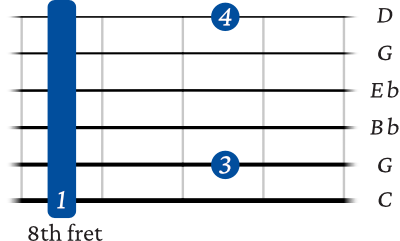
3. C minor 9 rootless 4th string
This is the same as the previous chord except using a rootless voicing.
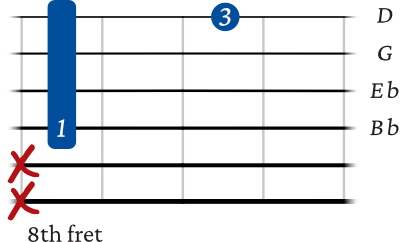
4. C minor 9 cluster on the 4th string
This shape is similar to the previous chord but uses a cluster, which refers to the dissonance of the half step between the 9th and b3 scale degrees.
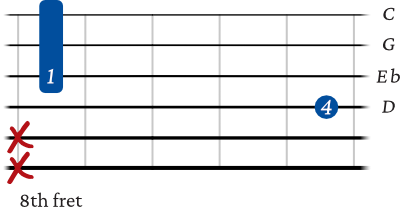

5. C minor 9 on 6th string variation

6. C minor 9 6th string variation 2
This chord is a bit of a stretch but also worth learning because of the full sound you get.
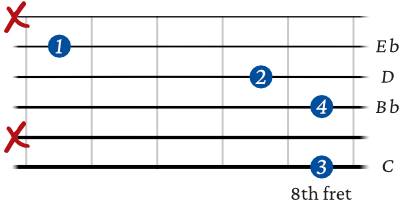
7. C minor 9 4th string variation
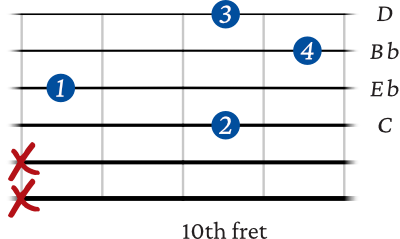
8. C minor 9 4th string variation 2
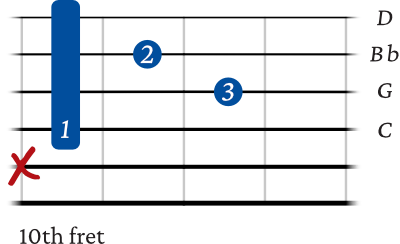
Wrapping Up
Building on the foundation of 7th chords, the C minor 9 chord incorporates an additional 9th interval on top of the C minor 7 chord structure. This extended chord adds a smooth and sophisticated sound that’s perfect for jazz, blues, and other genres.
You can play even more variations of this chord by using inversions on different strings. You can see this other lesson to learn how to play chord inversions on guitar.
If you want to take your chords even further, see this lesson on jazz chords on guitar.
📘 Get the free guitar practice guide here!
All the best,
JG Music Lessons
Start Playing Better, Faster
with Pro Membership! ✨
Get the guidance, tools, and support that keep your progress on track:
🏁 Always know what to practice next. Access the full Guitar Learning Roadmap with lessons in sequence.
🎼 Play songs with confidence. Step-by-step lessons of popular, classical pieces and other styles.
📙 Save time and frustration. Clear PDFs and ebooks that save time so you can focus on playing.
🎟️ Get rewarded for consistency. 2 free downloads every month (a $240+ yearly value).
🎁 Keep costs low while you grow. 50% off all charts, tracks, and posters — up to 75% off bundles.
🚫 Stay focused. Ad-free environment keeps you in the zone.
💬 Get help when you need it. Direct member support to keep you on track.

